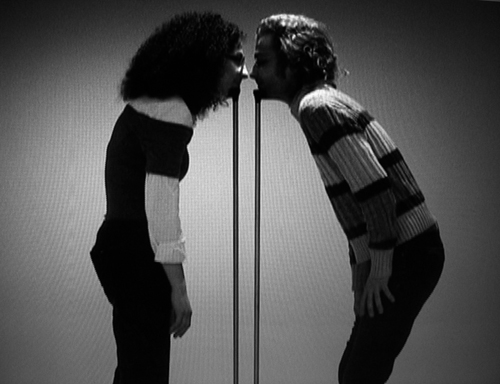
[Metal tubes, chin rests, wooden pedestal, acrylic paint]
your glance is the propeller that spins and drives the ghostly mobs
your glance is the fixed idea that drills through time, the motionless statue in the plaza of insomnia,
your glance weaves and unweaves the threads the fabric of space,
your glance rubs one idea against another and lights a lamp in the church of your skull,
. . . . . . . . . . . . . . . . . . . . . . . . . . . . . . . . . . . . . . . . . . . . . . . . . . . . . . . . . . . . . . . . . . . . . . . . . . . . . .
your eye is a hand, your hand has five eyes, your glance has two hands,
. . . . . . . . . . . . . . . . . . . . . . . . . . . . . . . . . . . . . . . . . . . . . . . . . . . . . . . . . . . . . . . . . . . . . . . . . . . . . .
we must populate the world with eyes, we must be loyal to sight, we must create in order to see.
Octavio Paz: For Roberto Matta, The House of Glances
Venus, the Roman myth along her Greek counterpart Aphrodite, have both been goddesses associated with love throughout the centuries. Many artists, writers and psychoanalysts have referenced one or the other because as any myth, they have become universal symbols for unmovable human events.
As indicated by William Hansen, a professor of Mythology and Classical Studies at Indiana University, Hesiod narrates in Theogony the story of how Aphrodite was born from the foam of Uranus’s castrated member tossed into the sea:
“Kronos [was] waiting in ambush upon the mainland (or, from another perspective, upon his mother Gaia) with a sickle in his hand. When Ouranos descends, stretching himself out over Gaia in order to engage in sexual intercourse, Kronos takes hold of his father’s genitals with his left hand, cuts them off with his adamantine sickle, and casts them behind him. As the severed organ hurtles through the air, blood falls from it onto the land below, impregnating Gaia with several kinds of offspring. It settles finally upon the waters of the sea; in time foam issuing from the organ surrounds it, and within the foam a girl coalesces (Hansen, W., 2000).”
The girl appearing from the sea’s foam is Aphrodite and whether Hansen further explores in his essay how being born from a phallus might account for Aphrodite’s attachment or love for it (thus becoming a fertility deity) is one valid point of view.
Intimacy and proximity acquired by gaze was the origin of this project. After long research around gaze and optical apparatuses, I fortuitously stumbled into the desire to capture the other’s gaze in something Grootenboer recalls from Marcia Pointon’s work, an expert who wrote extensively on British miniature portraiture:
“Taking the miniaturist’s exclusive focus on eyes as a confirmation of how gazing games revolve around portrait miniatures, Pointon considers the eye portrait as a condensed form of the miniature. Pace Pointon, I contend that the painted eye is not a synecdoche; it does not metonymically represent the whole face and, to go further, does not stand in for a loved one’s face, and not even for his or her eye. Rather, it stands in for his or her gaze. As a portrayal of a gaze rather than part of a face, the eye picture adds a significant aspect to the network of gazing games that remains unaddressed in portrait miniatures: namely, how the beholder could be subjected to someone’s gaze in the sense that she or he becomes a sight (Grootenboer, H., 2006).”
As a residue of my ophthalmologist visits, I remembered how chin rests were usually incorporated to machines that helped the doctor precise exact values for vision. I recalled the moment I had to place my chin towards them and in the process, become incredibly aware of my gaze. Even further, I can still recall there was something quite exciting from this visits: the darkened room, the face of the doctor as he approached very closely to look into each of my eyes and the playful nature of all these objects that by shifting secret mechanisms, changed my visual perceptions.
Gazing Game was a minimal abstraction of that proximity, one that without the same context radically changed the perception and the aim of these simple objects. It shifted the power of being placed to place oneself voluntarily to closeness, from mere scrutiny to admiration.
Special Thanks to Mary Choueiter, Mónica Martínez and Michael Bizon.